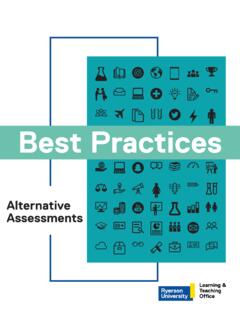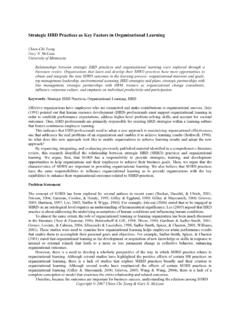Transcription of OUTLINE OF PRINCIPLES OF IMPACT EVALATION - discussion …
1 1 OUTLINE OF PRINCIPLES OF IMPACT EVALUATION PART I KEY CONCEPTS Definition IMPACT evaluation is an assessment of how the intervention being evaluated affects outcomes, whether these effects are intended or unintended. The proper analysis of IMPACT requires a counterfactual of what those outcomes would have been in the absence of the There is an important distinction between monitoring outcomes, which is a description of the factual, and utilizing the counterfactual to attribute observed outcomes to the intervention.
2 The IFAD IMPACT evaluation guidelines accordingly define IMPACT as the the attainment of development goals of the project or program, or rather the contributions to their attainment. The ADB guidelines state the same point as follows: project IMPACT evaluation establishes whether the intervention had a welfare effect on individuals, households, and communities, and whether this effect can be attributed to the concerned intervention . The counterfactual Counterfactual analysis is also called with versus without (see Annex A for a glossary).
3 This is not the same as before versus after, as the situation before may differ in respects other than the intervention. There are, however, some cases in which before versus after is sufficient to establish IMPACT , this being cases in which no other factor could plausibly have caused any observed change in outcomes ( reductions in time spent fetching water following the installation of water pumps). The most common counterfactual is to use a comparison group. The difference in outcomes between the beneficiaries of the intervention (the treatment group) and the comparison group, is a single difference measure of IMPACT .
4 This measure can suffer from various problems, so that a double difference, comparing the difference in the change in the outcome for treatment and comparison groups, is to be preferred. Purpose of IMPACT evaluation IMPACT evaluation serves both objectives of evaluation: lesson-learning and A properly designed IMPACT evaluation can answer the question of whether the program is working or not, and hence assist in decisions about scaling up. However, care must be taken about generalizing from a specific context.
5 A well-designed 1 The central objective of quantitative IMPACT evaluation is to unobserved counterfactual outcomes IMPACT Evaluation: methodological and operational issues, Asian Development Bank, September 2006; and determining the counterfactual is at the core of evaluation design , Judy Baker Evaluating the IMPACT of Development Projects on Poverty, World Bank, 2000. 2 See the DAC Evaluation Network report, Evaluation Feedback for Effective Learning and Accountability Report No 5, OECD Evaluation and Effectiveness Series, OECD (2001) for a fuller discussion of these functions of evaluation.
6 2impact evaluation can also answer questions about program design: which bits work and which bits don t, and so provide policy-relevant information for redesign and the design of future programs. We want to know why and how a program works, not just if it does. By identifying if development assistance is working or not, IMPACT evaluation is also serving the accountability function. Hence IMPACT evaluation is aligned with results-based management3 and monitoring the contribution of development assistance toward meeting the Millennium Development Goals.
7 When to do an IMPACT evaluation It is not feasible to conduct IMPACT evaluations for all interventions. The need is to build a strong evidence base for all sectors in a variety of contexts to provide guidance for policy-makers. The following are examples of the types of intervention when IMPACT evaluation would be useful: Innovative schemes Pilot programs which are due to be substantially scaled up Interventions for which there is scant solid evidence of IMPACT in the given context A selection of other interventions across an agency s portfolio on an occasional basis PART II EVALUATION DESIGN Key elements in evaluation design The following are the key elements in designing an IMPACT evaluation.
8 4 Deciding whether to proceed with the evaluation Identifying key evaluation questions The evaluation design should be embedded in the program theory The comparison group must serve as the basis for a credible counterfactual, addressing issues of selection bias (the comparison group is drawn from a different population than the treatment group) and contagion (the comparison group is affected by the intervention or a similar intervention by another agency). Findings should be triangulated The evaluation must be well contextualised 3 See the report for the DAC Evaluation Network Results-Based Management in Development Co-Operation Agencies: a review of experience (2000), for a discussion of the relationship between evaluation and results-based management (RBM).
9 The UNEG Task Force on Evaluation and Results Based Management is currently examining this relationship in further detail. 4 This list is adapted from Baker op. cit. 3 Establishing the program theory The program theory documents the causal (or results) chain from inputs to The theory is an expression of the log frame, but with a more explicit analysis of the assumptions underlying the theory. Alternative causal paths may also be identified. The theory must also allow for the major external factors influencing outcomes.
10 A theory-based evaluation design tests the validity of the assumptions. The various links in the chain are analyzed using a variety of methods, building up an argument as to whether the theory has been realized in practice. Using the theory-based approach avoids black box IMPACT evaluations. Black box evaluations are those which give a finding on IMPACT , but no indication as to why the intervention is or is not doing. Answering the why question requires looking inside the box, or along the results chain. Selecting the evaluation approach A major concern in selecting the evaluation approach is the way in which the problem of selection bias will be addressed.
















